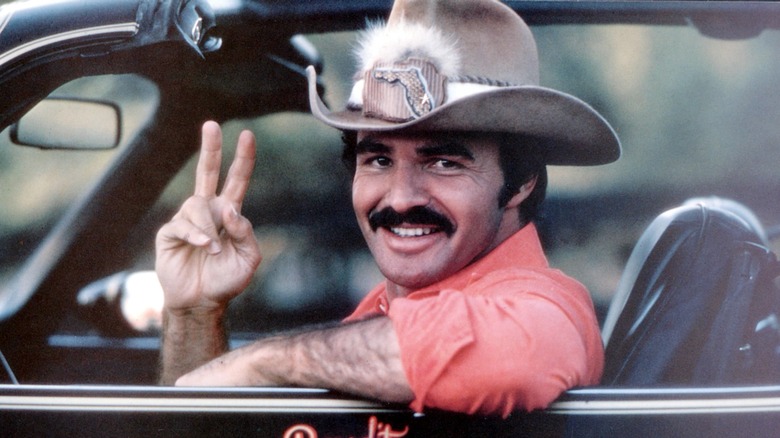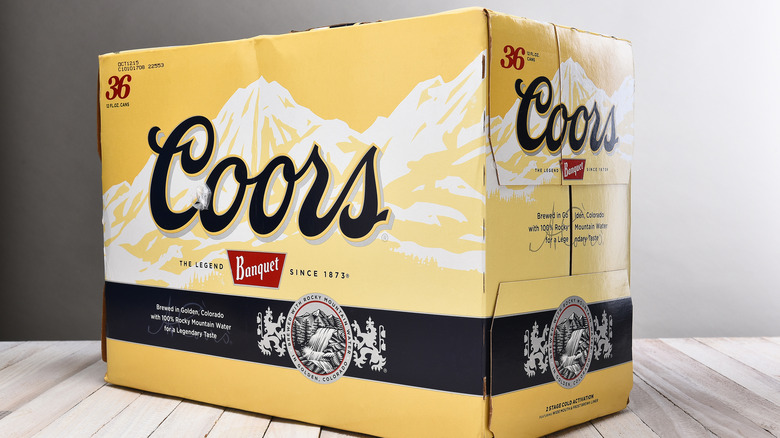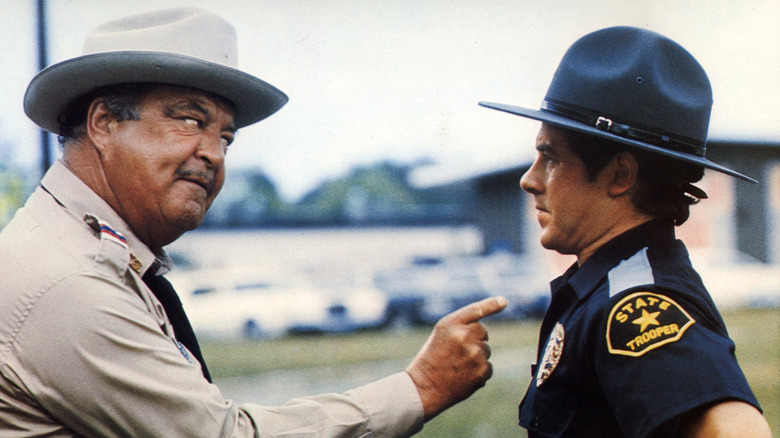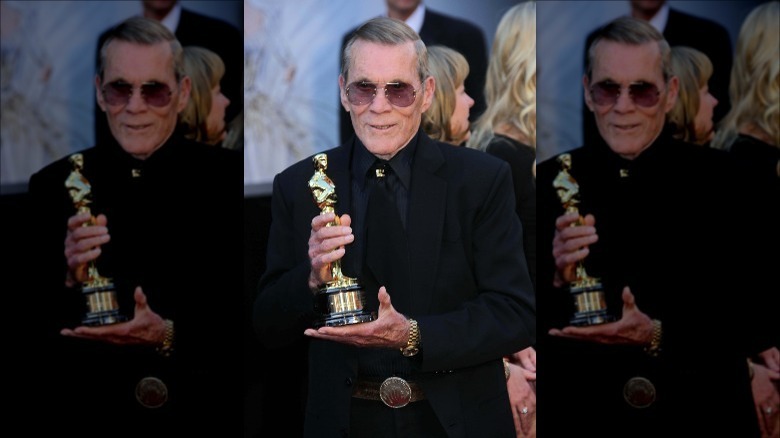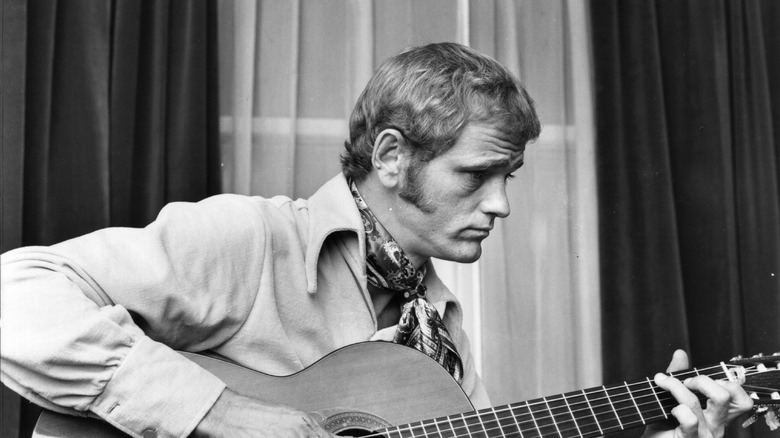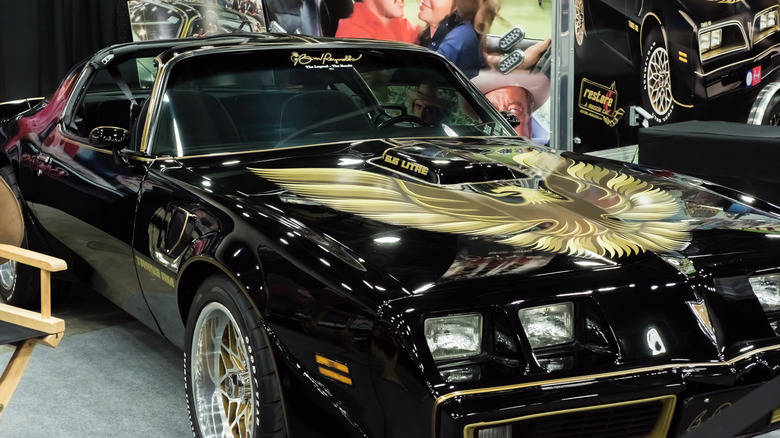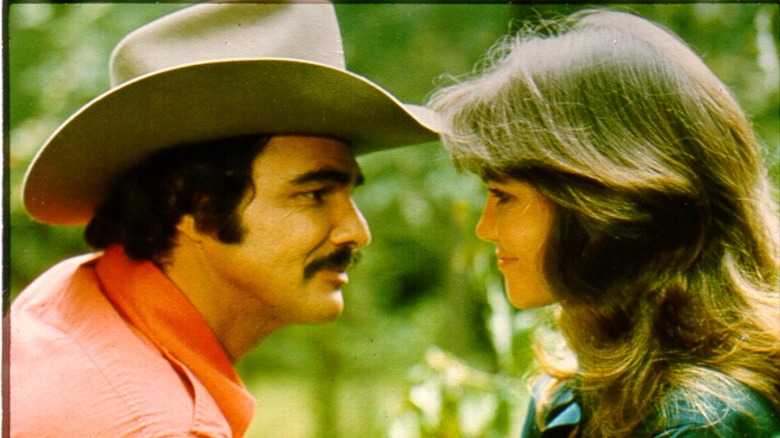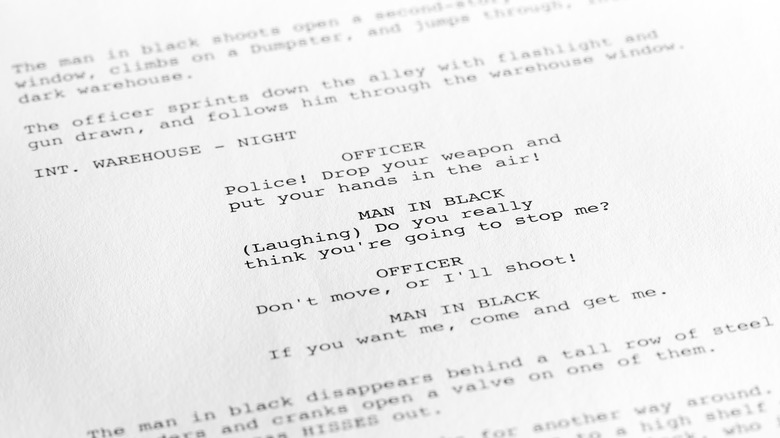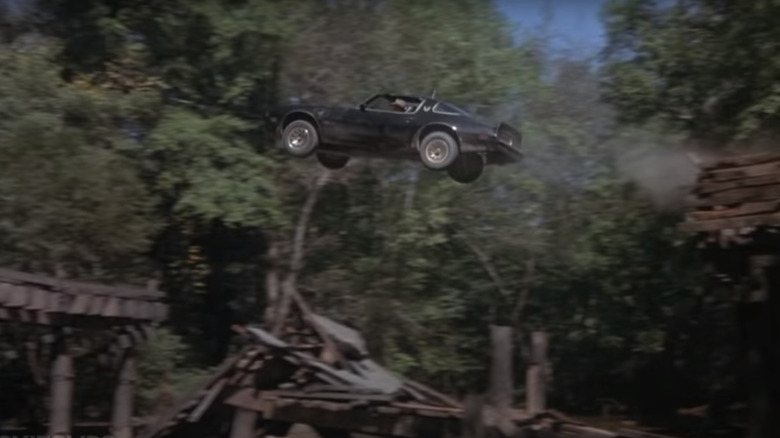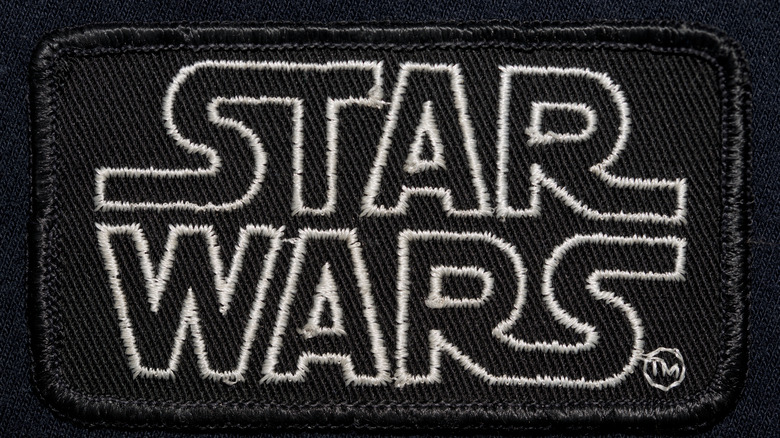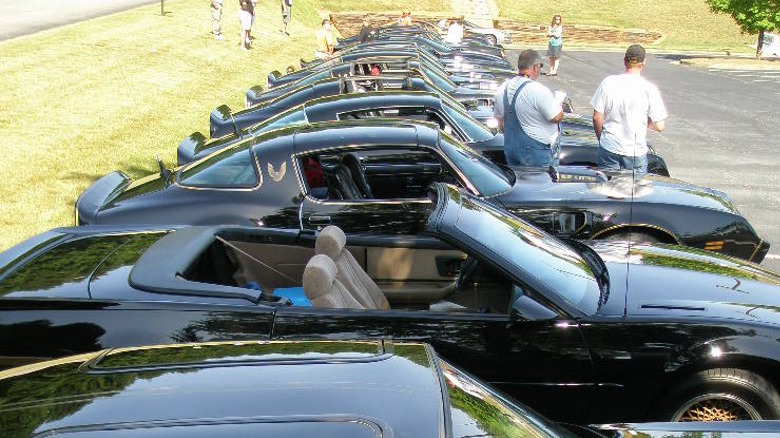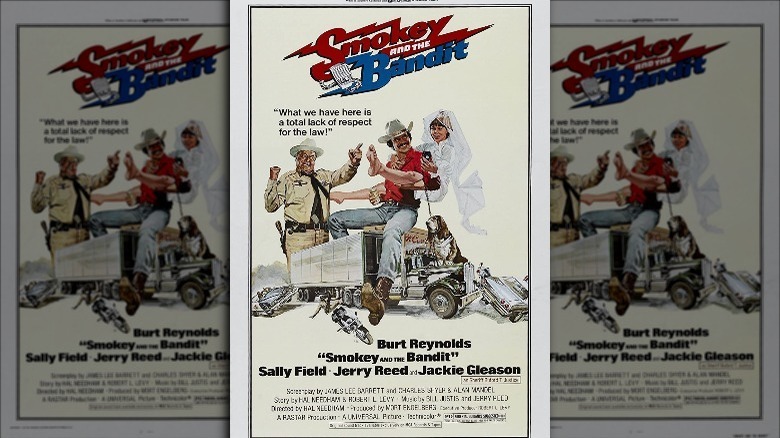The Untold Truth Of Smokey And The Bandit
In 1977 one of the most iconic films of all time was released, a movie that has only gained in relevance and reputation as the years have gone by. It had a distinctive look, spectacular stunts, and a leading man operating at the height of his charisma. It may also be the most 1970s movie of all time.
This is, of course, "Smokey and the Bandit," the Burt Reynolds comedy about two truckers, Cledus "Snowman" Snow and Bo "Bandit" Darville, who make a bet that they can smuggle 400 cases of Coors beer from Arkansas to Georgia in 28 hours — a feat that will require a lot of illegal driving in addition to the smuggling.
You might think that "Smokey and the Bandit" is about as big a hunk of 1970s cheese as you can find, and you are not wrong. But what glorious cheese it is. From Reynolds' incredible mustache to the gold Firebird logo on his Trans Am, this movie is part of pop culture for a lot of very good reasons, beginning with the fact that it's low-key hilarious and ending with its iconic re-imagining of the South. Here's the untold truth of "Smokey and the Bandit."
Coors beer really was unavailable east of the Mississippi
To modern viewers, the very premise of the film seems a little weird. Two rich guys want to serve classic Coors Banquet Beer at a party. Instead of just buying some, they seek out legendary figure Bo "Bandit" Darville and offer him $80,000 to get 400 cases of beer from Texarkana, Texas, to Atlanta, Georgia, in 28 hours. It's kind of silly.
Except it wasn't silly in 1977, because, as Vinepair reports, you really couldn't get Coors beer east of the Mississippi. In fact, this remained the case until 1986. Coors was a regional product of Colorado, and it wasn't pasteurized and contained no preservatives, which made shipping it beyond certain geographical limitations without a decline in quality impossible. Rather than deal with the headaches of spoiled beer, Coors simply didn't extend its distribution eastward beyond the Mississippi River. The New York Times notes that the lack of availability helped make Coors a legendary beer and that people actually did smuggle it.
The time limit is what gives the plot of the movie its tension. Snowman and Bandit can only win the bet if they exceed the speed limit the whole way, so they agree that Bandit will drive the flashy sports car to distract the cops (aka the "Smokies" in CB trucker lingo), while Snowman slips past unnoticed. According to Film School Rejects, it is actually possible to do the round-trip within the time limit at about 65 miles per hour.
Buford T. Justice was based on a real guy
Buford T. Justice, the county sheriff portrayed by the legendary Jackie Gleason, seems like a pretty broad comedic stereotype at first glance. In "Hick Flicks: The Rise and Fall of Redneck Cinema," author Scott Von Doviak explores the trend of films depicting comical Southern lawmen in the 1970s, and Justice could be seen as just another example of making the terrifying racist legacy of the South safe to laugh at.
But, the 11th Hour reports, Buford T. Justice is actually based on a real person. The Sun Sentinel explains that Burt Reynolds' father, Burton M. Reynolds Sr., was chief of police in Riviera Beach, Florida, and Reynolds based the character on a real police officer his father knew. According to author Scott Von Doviak, Gleason had performed a Southern sheriff routine for Reynolds that the star found hilariously accurate — extremely deferential to women and older folks, then viciously profane towards other men. Reynolds combined these characteristics with some actual phrases and mannerisms from his father's friend — including the classic profanity "sumbitch" — to craft the funny character. The genial cursing that Justice engages in was kind of edgy for a PG-rated film in 1977, which only added to the character's appeal.
The movie got made because the director was friends with Burt Reynolds
Hal Needham, the director and writer of "Smokey and the Bandit," was known as a legendary stunt man before making the film. TulsaWorld reports that he was also one of Burt Reynolds' best friends — they were so close, in fact, that after his divorce, Needham lived in Reynolds' pool house for 12 years. That's where he wrote the script for "Smokey and the Bandit."
Needham told Fortune that he originally hoped to get about $1 million to make the movie, and that he wanted to have country-singer-turned-actor Jerry Reed star in it. But when he showed the script to Reynolds — who was the No. 1 box office draw in the world at the time — the star said he had a six week opening in his schedule and that he'd star in the movie if Needham could get the funding.
Needham got meetings by dropping Reynolds' name, but no one wanted him to direct. Reynolds' friends and the studios were horrified. Reynolds wrote in his autobiography that his buddies literally begged him not to make the film, and the studios pushed him to make "Convoy" instead (Kris Kristofferson eventually starred in that one).
Needham eventually secured $5.3 million, $1 million of which was Reynolds' fee. Needham was left with $3.3 million to make the movie, but it went on to gross more than $120 million at the box office. Needham took home 3% of the profits.
Jerry Reed wrote the theme song in a few hours
As the New York Times reports, Jerry Reed was an established star by the time he appeared in "Smokey and the Bandit," with numerous Top 40 country hits and a handful of acting roles to his name. Reed was known for his unique style of guitar playing and the often humorous, good-natured sentiment of his songs. In fact, director Hal Needham originally cast Reed in the Bandit role for the film, before Burt Reynolds signed on.
Classic Country Music explains that Needham didn't have to look far to find someone to provide a soundtrack for the film, and Reed agreed to provide some songs. In his autobiography, Reynolds reports that Reed didn't deliver what would become his signature song until the last minute — after Needham reminded him, Reed went out all night and then somehow put "East Bound and Down" together (along with co-writer Dick Feller) in a few hours. The title is a reference to CB lingo, meaning the trucker is headed east and going off the air.
According to 105.7 News, when Reed played the song, he assumed that Needham didn't like it and offered to re-work it, but Needham reportedly said, "If you change one note, I'll kill you!" The song spent 16 weeks on the Billboard charts, peaking at No. 2. The song basically spells out the entire plot of the movie.
The Trans Ams were all trickery
As reported by TopSpeed, "Smokey and the Bandit" significantly boosted sales of the Pontiac Trans Ams — sales jumped from 68,745 units in 1977 to 117,108 by 1979. But anyone who bought one after watching the movie was probably a little disappointed because a lot of movie magic was used to make the car look faster and cooler than it actually was.
When the film went into production, no one thought it would be a huge hit, so director Hal Needham had trouble convincing Pontiac to give him cars. The company only provided him with four, which was barely enough — only one was even slightly functional at the end of production, and according to Hotcars, it had to be pushed by another car to get the final shots.
Not only was your standard Trans Am not capable of the stunts shown in the movie, the producers used all sorts of tricks. They dressed up 1976 models to look like the new 1977s about to come out, for one thing. For another, they raised and lowered the suspension to make some of the stunts possible. They also put stickers on the engine to make it appear to be a more powerful model than was actually included in a standard 1976 Trans Am. The final insult? The sound of the Trans Am roaring past isn't actually a Trans Am — it's a recording of a 1955 Chevrolet Custom.
Sally Field took the role to change her image
Sally Field was 31 when she took the role of Carrie, aka Frog, in "Smokey and the Bandit." She was already a big star, having played Gidget and the Flying Nun on television in the 1960s, and she'd just won an Emmy Award for her 1976 performance in "Sybil." But Field felt like she was at a crossroads in her career — she'd been a cute, adorable kid on TV, and now she'd proved she could really act, but she was worried about being perceived as ugly because of her role in "Sybil" and the fact that she'd never really been perceived as a sexy actress.
As Field told Oprah Winfrey, she felt she didn't fit in with the "tall, gorgeous models" she was competing with for roles. When Burt Reynolds called her personally to ask her to play the role, she was flattered and hoped it would change her image. "I thought if I did a movie with Burt and he thought I was cute, then somebody else might think I was cute and I could continue acting," she says. Reynolds likely did think she was cute — the two began a romantic relationship during production and were an on-and-off couple for years afterward.
There was no script
Although Hal Needham is credited as the writer of "Smokey and the Bandit" and has talked about writing the film while living in Burt Reynolds' pool house, there was apparently not much of a script. Sally Field told Oprah Winfrey that when Reynolds asked her to take the role, he admitted the script "wasn't very good" and that "in the end, we made up half the movie." Jay Chandrasekhar reports Reynolds telling him that the script for the film was just 60 pages long, half the typical length.
The AV Club reports that Field and Reynolds relied on their natural chemistry to make up their dialogue as they went, and author Scott Von Doviak reports Reynolds saying that Jackie Gleason, who always preferred spontaneity to rehearsals, made up most of his dialogue and routines. This was a case of a bunch of very talented people getting together and just having fun while being filmed, and getting paid a lot of money to do it.
The film sparked a fad for CB radios
If you were alive during the late 1970s, you might remember that there was a serious fad for CB radio, including the colorful slang vocabulary that had developed within the community. Films like "Smokey and the Bandit" had a lot to do with making CB and "trucker chic" culture cool, and introduced the general public to terms like "10-4."
As explained by CB World, the CB radio plays a huge part in the plot of "Smokey and the Bandit," as its the primary way Bandit, Snowman, and their trucker allies communicate with each other, warning of "smokies" laying in wait and advising each other on road conditions and other matters. In fact, people are still arguing over the gear that Bandit uses in the film.
Tropics of Meta says that this was about more than just a cool new fad. Truckers, the main users of CB radios, were increasingly seen as semi-outlaws and anti-authoritarian figures, and the CB radio and its coded language became identified with this low-key resistance. Snowman and Bandit are, after all, criminals — they're explicitly breaking laws and also endangering other drivers on the highways with their incredibly unsafe driving — but their crimes are framed as both harmless fun and anti-police, and they use the CB radio to humiliate Sheriff Buford Justice over and over again.
The director brought his stunt man expertise
If your impression of "Smokey and the Bandit" is that it's just one long excuse to film a lot of car chases and epic stunts, you're not totally wrong. Writer and director Hal Needham had trouble getting funding for the film because everyone knew him as a legendary stunt man rather than as a director.
According to Jesus Behind the Wheel, Needham was at one point the highest-paid stunt man in the world. He worked on more than 90 films doing stunts and paid a terrible price physically, breaking several bones and even breaking his back. NPR reports that the physical punishment inspired Needham to be an innovator — it was Needham who introduced the common-sense idea of using a gas-filled airbag to make falls from high spots safer. Before him, the industry used plywood boards and basic mattresses to breaks falls. Needham was also one of the first people to test airbag technology in cars and even testified to Congress about their necessity and efficacy.
A few years before Needham got the opportunity to make "Smokey and the Bandit," he transitioned to stunt driving, where he picked up many of the tricks of the trade that made the film's driving sequences so much fun. It's safe to say that without Needham's experience as a stunt man, it would have been a very different film.
It beat Star Wars at the box office
If you ask most people what famous movie came out in 1977, there's a pretty good chance they'll say "Star Wars." After all, that movie not only launched an iconic cultural institution, it also grossed more than $300 million worldwide (the equivalent of over $1.3 billion in today's money). But "Smokey and the Bandit" grossed a totally respectable $126,737,428, coming in second in the worldwide box office, and it also inspired two sequels of its own (though the less said about "Smokey and the Bandit 3," the better). And it even beat "Star Wars" at the box office. Sort of.
Decades explains that both films were released in May 1977, and that "Smokey and the Bandit" outdid "Star Wars" with a first-week haul of $1,728,060, compared to the other film's $1,554,475. But there are a couple of reasons this happened. First of all, no one in the universe thought "Star Wars" was going to be a big hit, so, as reported by the Numbers, it was only initially released on 43 screens. Second, Burt Reynolds was the biggest star in the world in 1977, so "Smokey and the Bandit" hit 498 screens right away. If you do the math on how much each film was making per screen, it's pretty clear which was likely to become an international juggernaut, but "Smokey and the Bandit" still has the distinction of beating "Star Wars" right out of the gate.
There's an official Bandit Run
If you've ever watched "Smokey and the Bandit" and thought it might be kind of cool to replicate the Bandit's route — maybe picking up a case of beer for yourself in Texarkana and driving it to Atlanta to share with friends — you're not alone.
The New York Times reports that an annual Bandit Run was established in 2007 to honor the 30th anniversary of the film. The initial Bandit Run attracted about 200 participants in 85 cars (not all of them were Trans Ams — any kind of vehicle was welcome to do the run) and followed the route from Texas to Atlanta outlined in the movie.
The idea came from two men: Dave Hall, who owns Restore a Muscle Car in Lincoln, Nebraska, and David Hershey, who owned a classic 1977 Trans Am. When Hershey brought the car to Hall to restore it to the film's original specs, they hit on the idea of replicating the run. There are no illegal moves and no need to haul beer — everyone just drives the route and has a good time. The Bandit Run is still going on, and seems likely to continue into the foreseeable future.
The film is deeper than you think
Saying that "Smokey and the Bandit" is deep will probably get you some disbelieving stares. It's a Burt Reynolds movie about smuggling beer and driving dangerously while making out with Sally Field. How deep could it be?
But, as the Los Angeles Times explains, even if the film isn't consciously deep, it represented a shifting perception of the South in the United States and is arguably an important representation of a re-branding effort. In the 1970s, the South was beginning to emerge from more than a century as a racially oppressive, violent place perceived as backwards and dangerous. As the economic and political prospects of the South were revived by the Republican Party's "Southern Strategy" and renewed investment in cities like Atlanta, the region wanted to put some distance between itself and images like Klan rallies and civil rights protests.
Tropics of Meta reports that, whether intentionally or not, "Smokey and the Bandit" represents this "new South" ideology. It's a South that can laugh at itself, and it's a South where there's hardly any reference to racial politics at all. It's a fun, freewheeling place where the Bandit and Snowman laugh at a racist old sheriff while still sporting the Confederate flag on their license plates.
